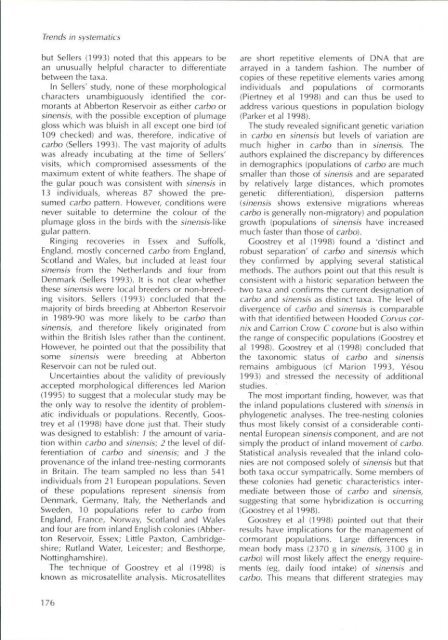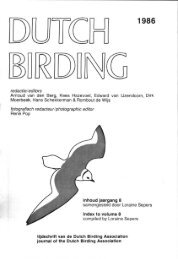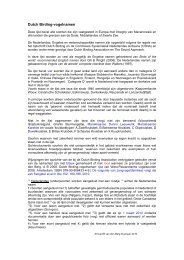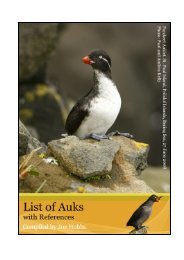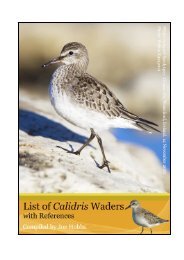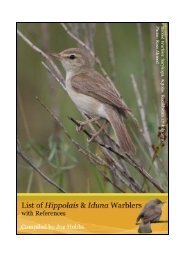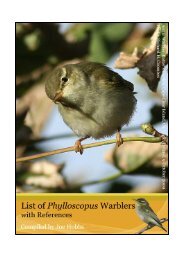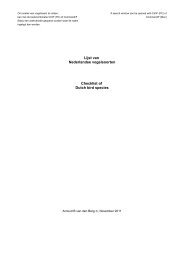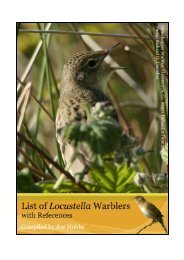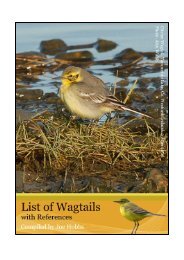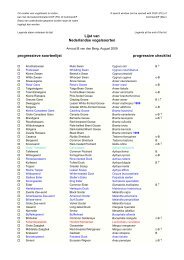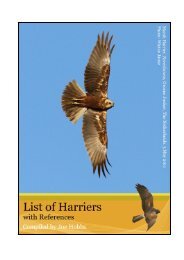1998-4 - Dutch Birding
1998-4 - Dutch Birding
1998-4 - Dutch Birding
You also want an ePaper? Increase the reach of your titles
YUMPU automatically turns print PDFs into web optimized ePapers that Google loves.
Trends in systernatic s<br />
but Sellers (1993 ) noted that this appears to be<br />
an unusually helpful character to differentiate<br />
hetween the taxa .<br />
In Sellers' study, none of these morphological<br />
characters unambiguc3usly identified the cormorants<br />
at Abberton Reservoir as either carbo or<br />
sinensis, with the possible exception ot plumage<br />
kloss which was bluish in all except one bird (of<br />
1 09 checked) and vvas, therefore, indicative of<br />
carbo (Sellers 199 3). The vast malority of adults<br />
,.vas already incubating at the time of Sellers'<br />
visits, which compromised assessments of the<br />
maximum extent of white feathers. The shape of<br />
the gular pouch was consistent with sinc:nsis in<br />
13 individuals, whereas 87 showed the presumed<br />
carbo pattern. However, conditions were<br />
never suitable to determine the colour of the<br />
plumage gloss in the birds with the sinensis-like<br />
gular pattern .<br />
Ringing recoveries in Essex and Suffolk,<br />
England, mostly concerned carlx) from England,<br />
Scotland and Wales, but included at least four<br />
sinensis trom the Netherlands and four from<br />
Denmark (Sellers 1993) . ft is not clear whether<br />
these sinensis were local breeders or non-breeding<br />
visitors . Sellers (1993) concluded that the<br />
majority ot hirds breeding at Abberton Reservoir<br />
in 1989-90 was more likeiy to be carbo than<br />
sinensis, and therefore likely originated from<br />
within the British tsles rather than the contineni .<br />
However, he pointed out that the possibility that<br />
some sinensis were breeding al Abberton<br />
Reservoir can not he ruled out .<br />
Uncertainties about the validity of previously<br />
accepted morpholo(;ical differences led Marion<br />
(1995) to suggest that a rnolecular study may be<br />
the only way to resolve the identity of prohlematic<br />
individuals or populations . Recently, Goostrey<br />
et al (<strong>1998</strong>) have done just that . Their study<br />
was designed to establish : 1 the amount of variation<br />
within carbo and sinensis; 2 the level ot differentiation<br />
of carbo and sinensis; and 3 the<br />
provenance of the inland tree-nestinK cormorants<br />
in Britain . The team sampled no less than 541<br />
individuals from 21 European populations . Seven<br />
of these populations represent sinensis from<br />
Denmark, Germany, Itafy, the Netherfands and<br />
Sweden, 10 populations refer to carbo from<br />
England, France, Norway, Scotland and Wales<br />
and four are from inland English colonies (Abberton<br />
Reservoir, Essex ; Little Paxton, Cambridgeshire;<br />
Rutland Water, Leicester ; and Besthorpe,<br />
Nottinf;hamshire) .<br />
The technieque of Goostrey et al (<strong>1998</strong>1 is<br />
known as microsatellite analysis . Microsatellites<br />
are short repetitive. elements of DNA that are<br />
arrayed in a tandem fashion . The number of<br />
copies of these repetitive elements varies among<br />
individuals and populations of cormorants<br />
(Piertney et al <strong>1998</strong>) and can thus be used to<br />
address various questions in population biology<br />
(Parker et al <strong>1998</strong>) .<br />
The study revealed significant genetic variation<br />
in carbo en sinensis but levels of variation are<br />
much higher in carbo than in sinensrs . The<br />
authors explained the discrepancy by differences<br />
in demographics (populations of carbo are much<br />
smaller than those of sinensis and are separated<br />
hy relatively large distances, which promotes<br />
genetic differentiation), dispersion patterns<br />
(sinensis shows extensive migrations whereas<br />
carbo is generally non-mi[=',ratorvj and population<br />
growth (populations of sinensis have increased<br />
much faster than those of carbo) .<br />
Goostrey et al 1<strong>1998</strong>) found a 'distinct and<br />
robust separation' of carbo and sinensis which<br />
they confirmed by applying several statistical<br />
methods . The authors point out that this result is<br />
consistent with a historic separation between the<br />
two taxa and confirms the current designation ot<br />
carbo and sinensis as distinct taxa . The level of<br />
divergente of c arbo and sinensi.s is comparable<br />
with that identified between Hooded Corti~us cornix<br />
and Carrion Crow C corone hut is also within<br />
the range of conspecific populations (Goostrey et<br />
al <strong>1998</strong>) . Goostrey et al (<strong>1998</strong>) concluded that<br />
the taxonomic status of carbo and sinensis<br />
remains amhiguous (d Marion 1993, Yésou<br />
1993) and stressed the necessity of additional<br />
studies .<br />
The most important finding, however, was that<br />
the inland populations clustered with sinensis in<br />
phylo#;enetic analyses . The tree-nesting colonies<br />
thus most likely consist of a considerable continental<br />
European sinensis component, and are not<br />
simply the product of inland movement of carbo .<br />
Statistical analysis revealed that the infand colonies<br />
are not composed solely of sinensis but that<br />
both taxa occur sympatrically. Some memhers of<br />
these colonies had genetic characteristics intermediate<br />
between those of carbo and sinensis,<br />
suggesting that some hyhridization is occurring<br />
(Goostrey et al <strong>1998</strong> ) .<br />
Goostrey et al f<strong>1998</strong>) pointed out that their<br />
results have irnplicatíons for the management of<br />
cormorant populations . Large difterences in<br />
mean hody mass (2370 g in sinensis, 3100 g in<br />
carbo} will most likely affect the energy requirements<br />
feg, daily food intakef of sinensis and<br />
carbo. This means that different strategies may<br />
170


